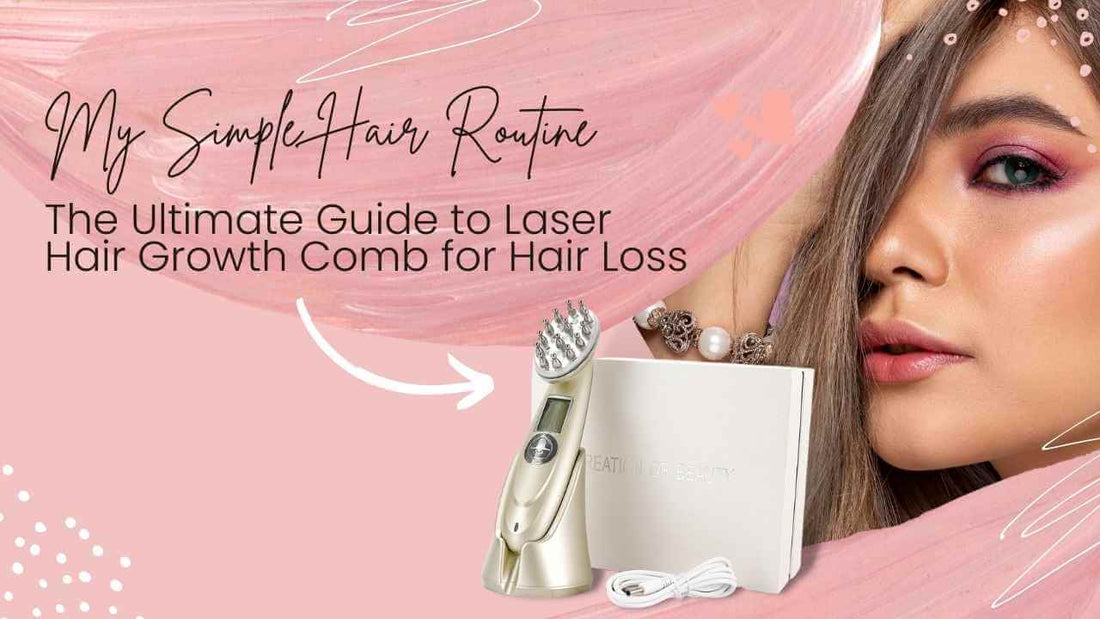
Laser Hair Growth Comb for Hair Loss
Share
Introduction
Hair loss is a common concern that affects a significant number of individuals worldwide. Whether due to genetics, hormonal changes, or other factors, losing hair can have a profound impact on one's self-esteem and overall well-being. In the search for effective solutions, laser hair growth combs have emerged as a promising option. In this comprehensive guide, we will delve into the world of laser hair growth combs, exploring their potential to combat hair loss and rejuvenate your mane.
The prevalence of hair loss
Hair loss is a widespread condition that affects both men and women. Studies show that approximately 50 million men and 30 million women in the United States alone experience some degree of hair loss. From receding hairlines to thinning crowns, the impact of hair loss can be emotionally distressing for individuals of all ages.
Exploring the need for effective hair loss solutions
Given the emotional and psychological toll of hair loss, it is no wonder that people seek effective solutions to combat this issue. From traditional remedies to advanced medical treatments, the quest for regaining a full head of hair has led to significant advancements in the field. One such innovation is the laser hair growth comb, a device that utilizes low-level laser therapy (LLLT) to stimulate hair follicles and promote hair growth. Let's dive deeper into this innovative approach and explore its potential benefits.
Stay tuned for the next sections of this ultimate guide, where we will uncover the science behind laser hair growth, discuss the mechanism of action of laser hair growth combs, and explore their benefits and limitations in detail.
Understanding Hair Loss
Hair loss can be a distressing experience, impacting individuals of all genders and ages. To effectively address hair loss concerns, it is crucial to understand the underlying factors and how they contribute to this condition. In this section, we will explore different types of hair loss, delve into the causes and contributing factors, and discuss the psychological impact it can have on individuals.
Different types of hair loss
Hair loss can manifest in various forms, each with its own characteristics and causes. Some common types of hair loss include:
- Androgenetic Alopecia: This hereditary form of hair loss, also known as male or female pattern baldness, is the most common type. It typically follows a specific pattern, such as receding hairline in men or thinning hair on the crown in women.
- Alopecia Areata: This autoimmune condition results in patchy hair loss on the scalp or other parts of the body. It occurs when the immune system mistakenly attacks hair follicles.
- Telogen Effluvium: This type of hair loss is often temporary and occurs when a significant number of hair follicles enter the resting (telogen) phase. It can be triggered by factors like physical or emotional stress, hormonal changes, or certain medications.
- Traction Alopecia: This form of hair loss occurs when hair is subjected to constant pulling or tension, often due to tight hairstyles like braids, ponytails, or extensions.
Causes and contributing factors
Hair loss can be influenced by a variety of factors, including:
- Genetics: Family history plays a significant role in determining the likelihood of experiencing hair loss. Certain genes can make individuals more susceptible to pattern baldness.
- Hormonal Changes: Hormonal imbalances, such as those occurring during pregnancy, childbirth, menopause, or thyroid disorders, can contribute to hair loss.
- Medical Conditions: Certain medical conditions, such as scalp infections, autoimmune disorders, and hormonal disorders, can lead to hair loss.
- Lifestyle and Environmental Factors: Poor nutrition, excessive stress, smoking, and exposure to harsh chemicals or pollutants can contribute to hair loss.
The psychological impact of hair loss
Hair loss can have a profound psychological impact on individuals, affecting their self-esteem, body image, and overall emotional well-being. Many people feel self-conscious and may experience feelings of embarrassment, anxiety, or even depression. Understanding the psychological effects of hair loss is crucial in providing holistic support and practical solutions.
By understanding the different types of hair loss, exploring the causes and contributing factors, and recognizing the psychological impact, we can better comprehend the complexities of this condition. In the following sections, we will delve into the science behind laser hair growth, the functionality of laser hair growth combs, and their potential as a solution for hair loss.
The Science Behind Laser Hair Growth
Laser hair growth has emerged as an innovative and non-invasive approach to combat hair loss. By utilizing the power of laser therapy, this technique aims to stimulate hair growth and revive dormant hair follicles. In this section, we will explore how laser therapy stimulates hair growth, delve into the mechanisms of action, and examine the clinical evidence that supports the effectiveness of laser hair growth.
How laser therapy stimulates hair growth
Laser therapy, also known as low-level laser therapy (LLLT) or red light therapy, involves the use of specific wavelengths of light to stimulate cellular activity within the hair follicles. The photons emitted by the laser devices are absorbed by the cells in the scalp, triggering a series of biological responses.
One key mechanism is the stimulation of adenosine triphosphate (ATP) production within the cells. ATP provides energy to the cells, including those in the hair follicles. By increasing ATP production, laser therapy enhances the metabolic activity and cellular function of the follicles, promoting hair growth.
Furthermore, laser therapy is believed to improve blood circulation in the scalp. Dating blood vessels and increasing blood flow to the hair follicles ensures a better supply of oxygen, nutrients, and growth factors. This optimized environment supports the health and vitality of the hair follicles, encouraging the growth of stronger and thicker hair.
Mechanisms of action
Laser hair growth works through multiple mechanisms to promote hair growth. Apart from increasing ATP production and improving blood circulation, laser therapy also:
- Reduces inflammation: Chronic inflammation in the scalp can hinder hair growth. Laser therapy helps reduce inflammation, creating a favorable environment for hair follicle health and regeneration.
- Extends the anagen (growth) phase: The anagen phase is the active growth phase of the hair follicles. Laser therapy prolongs this phase, allowing hair to grow for an extended period before transitioning to the resting and shedding phases.
- Counteracts the effects of dihydrotestosterone (DHT): DHT is a hormone associated with hair loss in individuals with androgenetic alopecia. Laser therapy can help counteract the negative effects of DHT, protecting the hair follicles from miniaturization and promoting healthy hair growth.
Clinical evidence supporting laser hair growth
Numerous studies have explored the efficacy of laser hair growth in treating hair loss. Clinical trials and research have provided compelling evidence to support its effectiveness. These studies have demonstrated that laser therapy can significantly increase hair density, improve hair thickness, and promote regrowth in individuals experiencing hair loss.
In addition to controlled clinical studies, real-life experiences, and testimonials from individuals who have used laser hair growth devices further validate its positive outcomes. These success stories reinforce the potential of laser hair growth as a viable solution for hair loss.
As we continue our journey through this ultimate guide, the next sections will introduce laser hair growth combs, explain their functionality, and explore their benefits and limitations.
Introducing Laser Hair Growth Combs
Laser hair growth combs have gained popularity as a convenient and effective solution for addressing hair loss. In this section, we will introduce you to the world of laser hair growth combs, discussing what they are, exploring their features and types, and comparing them with other hair loss treatments.
What are laser hair growth combs?
Laser hair growth combs are handheld devices that combine the benefits of low-level laser therapy (LLLT) with the convenience of a comb-like design. These combs emit therapeutic laser light directly to the scalp, stimulating hair follicles and promoting hair growth. The comb's teeth allow for even distribution of laser light across the scalp, ensuring comprehensive coverage.
Designed for home use, laser hair growth combs offer individuals the convenience of treating their hair loss in the comfort of their own homes. With regular use, these combs aim to improve the density and thickness of hair, while also revitalizing dormant hair follicles.
Features and types of combs available
Laser hair growth combs come in various models, each with its own set of features and functionalities. Here are some common features to look for:
- Laser Diodes: The number of laser diodes in the comb determines the coverage and intensity of the laser therapy. A higher diode count generally offers more effective treatment.
- Adjustable Settings: Some combs allow users to adjust the power and intensity of the laser therapy, accommodating individual preferences and needs.
- Rechargeable Battery: Look for combs with a rechargeable battery to ensure convenient and cost-effective usage.
- User-Friendly Design: Consider combs that are ergonomically designed, comfortable to hold, and easy to maneuver across the scalp.
When exploring the types of combs available, you may come across variations such as laser hair growth brushes or helmets. These options provide alternative ways to deliver laser therapy to the scalp, catering to individual preferences and needs.
Comparison with other hair loss treatments
Laser hair growth combs offer a non-invasive and drug-free approach to combating hair loss. When compared to other hair loss treatments, such as medications or invasive procedures, laser hair growth combs have several advantages:
- Safety: Laser hair growth combs are generally considered safe for home use, with minimal risk of side effects or complications.
- Convenience: With a laser hair growth comb, you have the flexibility to treat your hair loss at your convenience and in the comfort of your own home, eliminating the need for frequent visits to clinics or salons.
- Non-Invasiveness: Unlike surgical procedures or hair transplant surgeries, laser hair growth combs do not require any invasive techniques or recovery periods.
- Cost-Effectiveness: In the long run, laser hair growth combs can be a more cost-effective option compared to ongoing expenses associated with medications or salon treatments.
As we move forward in this ultimate guide, we will delve deeper into how laser hair growth combs work, explore their benefits and limitations, and provide guidance on choosing the right comb for your needs.
How Laser Hair Growth Combs Work
Laser hair growth combs utilize the power of low-level laser therapy (LLLT) to stimulate hair follicles, promote hair growth, and rejuvenate the scalp. In this section, we will explore the functionality of laser hair growth combs, how they penetrate the scalp with LLLT, and the process of promoting cellular activity and hair follicle rejuvenation.
Overview of the comb's functionality
Laser hair growth combs are designed with the primary purpose of delivering therapeutic laser light to the scalp. The comb's teeth, typically made of medical-grade lasers, emit low-level laser beams directly onto the scalp's surface. These laser beams penetrate the skin and reach the hair follicles, initiating a series of biological responses.
The comb's functionality involves the precise delivery of laser therapy to the targeted areas of the scalp. By using the comb in a gentle, sweeping motion, the laser light evenly distributes across the scalp, ensuring comprehensive coverage and treatment of hair follicles.
Penetrating the scalp with low-level laser therapy (LLLT)
Low-level laser therapy (LLLT) is the cornerstone of how laser hair growth combs work. The therapeutic laser light emitted by the comb has specific wavelengths that can penetrate the scalp's layers without generating heat or causing damage. The laser beams reach the hair follicles, stimulating cellular activity and triggering biological responses.

The penetration of the scalp by LLLT has several benefits. It allows the laser light to reach the hair follicles directly, where it can have the most impact. The non-invasive nature of LLLT ensures a comfortable and painless experience for users, without any risk of burns or discomfort.
Promoting cellular activity and hair follicle rejuvenation
Once the laser light reaches the hair follicles, it stimulates cellular activity and promotes hair follicle rejuvenation. The photons from the laser beams are absorbed by the cells in the scalp, activating various biological processes.
One crucial effect is the increased production of adenosine triphosphate (ATP) within the cells. ATP provides energy to the cells, including those in the hair follicles, promoting their metabolic activity and overall function. This enhanced cellular activity helps rejuvenate dormant hair follicles, stimulating hair growth and improving the quality of existing hair.
Furthermore, laser therapy also promotes the release of nitric oxide, a molecule that plays a role in vasodilation and improves blood circulation. By enhancing blood flow to the hair follicles, laser therapy ensures a better supply of oxygen, nutrients, and growth factors. This nourishes the follicles, supporting their health and vitality, ultimately leading to stronger and thicker hair.
Understanding how laser hair growth combs work is essential in harnessing their potential for combating hair loss. In the next sections of this ultimate guide, we will explore the benefits and limitations of laser hair growth combs, provide tips for using them effectively, and address common questions and concerns related to their usage.
Benefits and Limitations of Laser Hair Growth Combs
Laser hair growth combs have gained popularity as a convenient and non-invasive solution for addressing hair loss. In this section, we will explore the benefits of using laser hair growth combs, highlighting their advantages. Additionally, we will discuss considerations and potential limitations that individuals should be aware of when using these combs.
Advantages of using laser hair growth combs
- Non-Invasive: Laser hair growth combs offer a non-invasive approach to combating hair loss. Unlike surgical procedures or medications that may have side effects, these combs use low-level laser therapy (LLLT), which is safe and gentle on the scalp.
- Convenience: With laser hair growth combs, individuals have the convenience of treating their hair loss in the comfort of their own homes. There's no need for frequent visits to clinics or salons, saving time and money in the long run.
- Cost-Effective: Laser hair growth combs can be a cost-effective solution compared to ongoing expenses associated with medications or salon treatments. Investing in a quality comb allows for long-term use without incurring additional costs.
- Versatility: Laser hair growth combs are suitable for both men and women experiencing hair loss. They can be used in various stages of hair loss, from early signs to advanced conditions.
- Enhanced Hair Health: Regular use of laser hair growth combs can improve the overall health of the hair. It can promote thicker, stronger hair growth and revitalize dormant hair follicles.
Considerations and potential limitations
-
- Consistency is Key: To achieve optimal results, it is important to use laser hair growth combs consistently and as directed. Skipping sessions or inconsistent use may impact the effectiveness of the treatment.
- Time Commitment: Laser hair growth requires a time commitment, as individual sessions can take several minutes. It is essential to set aside dedicated time for treatment to ensure consistent and effective use.
- Patience is Required: Hair growth is a gradual process, and visible results may take time to become noticeable. It is important to have realistic expectations and understand that individual results may vary.
- Not Suitable for All Hair Loss Types: While laser hair growth combs are effective for certain types of hair loss, such as androgenetic alopecia, they may not be as effective for all types of underlying medical conditions causing hair loss. Consulting with a healthcare professional can help determine suitability.
- Maintenance and Upkeep: Some laser hair growth combs may require battery replacement or maintenance over time. It is important to follow the manufacturer's instructions and ensure proper care of the device for optimal longevity.
Understanding the benefits and limitations of laser hair growth combs allows individuals to make informed decisions regarding their hair loss treatment. In the next sections, we will provide tips for the effective use of laser hair growth combs, answer frequently asked questions, and provide additional insights to guide individuals on their journey toward regaining healthy and vibrant hair.
Choosing the Right Laser Hair Growth Comb
Selecting the right laser hair growth comb is essential for maximizing the effectiveness of your hair loss treatment. In this section, we will explore the factors to consider before making a purchase, the evaluation of comb features and specifications, and the significance of user reviews and testimonials in the decision-making process.

Factors to consider before making a purchase
- Hair Loss Type: Understand the type of hair loss you are experiencing. Different laser hair growth combs may be more effective for specific types of hair loss, such as androgenetic alopecia or thinning hair due to other factors. Consider whether the comb you are considering is suitable for your specific hair loss condition.
- Treatment Area: Assess the size of the treatment area. Some laser hair growth combs have a larger coverage area, which can be beneficial for individuals with extensive hair loss. Choose a comb that can effectively cover the target area of your scalp.
- Ease of Use: Consider the user-friendliness of the comb. Look for features such as an ergonomic design, comfortable grip, and intuitive controls. A comb that is easy to handle and maneuver will ensure convenient and hassle-free treatment sessions.
- Adjustability and Customization: Evaluate whether the comb offers adjustable settings to accommodate individual preferences and treatment needs. The ability to control power levels or treatment duration can enhance the flexibility and effectiveness of the therapy.
Evaluating comb features and specifications
-
- Laser Diode Count: Pay attention to the number of laser diodes in the comb. A higher diode count can provide more comprehensive coverage and potentially deliver more effective treatment.
- Laser Wavelength: Check the wavelength of the laser light emitted by the comb. Different wavelengths may have varying levels of penetration and effectiveness. Look for combs with wavelengths proven to be effective for hair growth stimulation.
- Battery Life and Charging: Consider the battery life and charging options of the comb. Longer battery life ensures uninterrupted treatment sessions, while rechargeable batteries offer convenience and cost-effectiveness.
- Safety Features: Verify if the comb incorporates safety features such as automatic shut-off or timers to prevent overuse or excessive exposure to laser therapy.
User reviews and testimonials
When choosing a laser hair growth comb, it is valuable to read user reviews and testimonials. Real experiences shared by others who have used the comb can provide insights into its effectiveness, user-friendliness, and overall satisfaction. Look for reviews from individuals with similar hair loss conditions to gain a better understanding of how the comb may work for you.
Consider reputable sources for user reviews and testimonials, such as verified product reviews on trusted websites or feedback from reputable hair loss communities and forums. However, keep in mind that individual results may vary, and it is essential to consider a variety of opinions before making a decision.

By carefully considering the factors, evaluating comb features, and researching user reviews, you can make an informed decision and choose the laser hair growth comb that best aligns with your needs and expectations. In the upcoming sections, we will delve into tips for the effective use of laser hair growth combs, address common concerns and misconceptions, and provide guidance on incorporating these combs into your hair care routine.
How to Use a Laser Hair Growth Comb
Using a laser hair growth comb properly is crucial to achieving the desired results in combating hair loss. In this section, we will provide a step-by-step guide on using the comb effectively, discuss the frequency and duration of combing sessions, and offer tips on maintaining and caring for your comb.

A step-by-step guide to using the comb effectively
-
- Cleanse and Dry: Start by ensuring that your scalp is clean and dry before using the laser hair growth comb. Remove any styling products, oils, or residue that may hinder the penetration of the laser light.
- Divide the Scalp: Divide your scalp into sections to ensure thorough coverage. This can be done by parting the hair using a comb or your fingers. Divide it into sections that are easy to manage during the combing process.
- Power on the Comb: Switch on the laser hair growth comb and familiarize yourself with the controls and settings. Adjust the power level according to your comfort and the recommended guidelines provided by the manufacturer.
- Begin Combing: Starting from the front of your scalp, gently glide the comb through each section of your hair. Make sure the comb's teeth make direct contact with your scalp. Use slow and steady motions to ensure that the laser light has sufficient time to penetrate the scalp.
- Overlap the Sections: As you move from one section to another, slightly overlap the previously combed area to ensure complete coverage. This helps to maximize the effectiveness of the laser therapy on all areas of the scalp.
- Cover the Entire Scalp: Continue combing until you have covered the entire scalp. Pay special attention to areas where hair loss is more prominent or where you desire increased hair growth.
- Recommended Session Duration: Follow the manufacturer's recommendations for the duration of each combing session. Typically, sessions range from 10 to 15 minutes, but this may vary depending on the specific comb model
Frequency and duration of combing sessions
Consistency is key when using a laser hair growth comb. The recommended frequency of combing sessions may vary depending on the comb model and individual needs. Generally, it is advised to use the comb three to four times per week.
Each session should last for the recommended duration provided by the manufacturer. Avoid excessive or prolonged use as it may not necessarily accelerate the results. Adhering to the recommended frequency and duration ensures that you receive the optimal benefits of the comb's laser therapy.
Maintaining and caring for your comb
To ensure the longevity and effectiveness of your laser hair growth comb, proper maintenance and care are essential. Follow these tips to maintain your comb:
- Cleaning: Regularly clean the comb's teeth with a soft, damp cloth to remove any debris or buildup. Avoid using harsh chemicals or abrasive materials that may damage the comb.
- Storage: Store the comb in a safe and dry place when not in use. Protect it from excessive heat, moisture, or direct sunlight, as these conditions can affect its performance.
- Battery Care: If your comb is battery-powered, follow the manufacturer's instructions for battery replacement and charging. Properly maintaining the battery ensures consistent power during combing sessions.
- Check for Damage: Regularly inspect the comb for any signs of damage or wear. If you notice any issues, such as loose wires or malfunctioning components, contact the manufacturer for assistance.
By following these guidelines on how to use a laser hair growth comb, understanding the recommended frequency and duration of sessions, and maintaining proper care, you can optimize the benefits of the comb and enhance your hair loss treatment journey. In the upcoming sections, we will address common questions and concerns related to laser hair growth combs and provide additional.
Safety and Precautions
When using a laser hair growth comb, it is important to prioritize safety and take necessary precautions to ensure an effective and risk-free experience. In this section, we will discuss how to ensure the safe usage of laser hair growth combs, address possible side effects and how to minimize them, and provide precautions for specific medical conditions.
Ensuring safe usage of laser hair growth combs
- Follow the Instructions: Carefully read and follow the instructions provided by the manufacturer. Pay close attention to recommended usage guidelines, power levels, and session durations. Adhering to these instructions ensures safe and effective treatment.
- Avoid Direct Eye Contact: Laser hair growth combs emit low-level laser therapy (LLLT) that is designed for scalp use. However, it is important to avoid direct eye contact with the laser light to protect your eyes. If accidentally exposed, rinse your eyes thoroughly with water and seek medical attention if necessary.
- Keep Away from Children: Ensure that laser hair growth combs are kept out of reach of children. These devices should only be used by individuals who can understand and follow the necessary precautions.
- Do Not Share the Comb: Laser hair growth combs should not be shared with others. Each person's hair loss condition and treatment needs are unique, and sharing the comb may increase the risk of cross-contamination or improper usage.
Possible side effects and how to minimize them
While laser hair growth combs are generally safe to use, some individuals may experience minor side effects. These side effects are usually temporary and should subside over time. However, if you experience persistent or severe side effects, it is recommended to consult a healthcare professional. Here are some common side effects and how to minimize them:
- Scalp Sensitivity: Some individuals may experience mild scalp sensitivity during or after combing sessions. To minimize this, start with a lower power setting and gradually increase as your scalp adjusts to the therapy. If the sensitivity persists, consider using the comb every other day instead of daily.
- Mild Redness or Irritation: Temporary redness or irritation of the scalp may occur, especially for individuals with sensitive skin. To minimize this, ensure that your scalp is clean and free from any irritants before using the comb. If redness or irritation persists, discontinue use and consult a healthcare professional.
- Dryness or Flaking: In rare cases, laser hair growth combs may contribute to temporary dryness or flaking of the scalp. To prevent or alleviate this, maintain a regular hair care routine that includes moisturizing the scalp with gentle, nourishing products.
Precautions for specific medical conditions
While laser hair growth combs are generally safe for most individuals, certain medical conditions or medications may require additional precautions. If you have any of the following conditions, consult a healthcare professional before using a laser hair growth comb:
- Skin Sensitivities or Disorders: If you have a history of skin sensitivities, allergies, or any underlying scalp conditions, it is important to seek medical advice to ensure the suitability of using a laser hair growth comb.
- Skin Cancer or Lesions: Individuals with a history of skin cancer or active skin lesions should avoid using laser hair growth combs on or near affected areas. Consult with a healthcare professional for appropriate guidance.
- Photosensitive Medications: Some medications can make the skin more sensitive to light. If you are taking any photosensitive medications, it is important to consult with your healthcare provider before using a laser hair growth comb.
By following safety guidelines, being aware of possible side effects, and considering specific medical conditions, you can ensure a safe and effective experience while using a laser hair growth comb. In the next sections
Complementary Hair Care Practices
While laser hair growth combs can be an effective tool in combating hair loss, incorporating complementary hair care practices can further enhance the health and growth of your hair. In this section, we will explore adopting a holistic approach to hair health, discuss nutritional considerations for hair growth, and examine the impact of lifestyle habits on hair loss.
Adopting a holistic approach to hair health
To promote optimal hair growth and overall hair health, it is essential to adopt a holistic approach that considers various factors beyond just using a laser hair growth comb. Here are some key aspects to focus on:
- Stress Management: High levels of stress can contribute to hair loss. Incorporate stress management techniques such as regular exercise, meditation, deep breathing exercises, and adequate sleep to help maintain a balanced mind and body.
- Scalp Care: Pay attention to your scalp health by keeping it clean and free from excessive oil and product buildup. Gently massage your scalp to improve blood circulation and promote a healthy environment for hair growth.
- Regular Exercise: Engaging in regular physical activity promotes overall circulation, including to the scalp. Exercise stimulates blood flow, which can nourish hair follicles and promote hair growth.
- Hair Styling Practices: Be mindful of harsh styling practices that can cause damage to your hair, such as excessive heat styling, tight hairstyles, and chemical treatments. Opt for gentler styling methods and use heat protectants when necessary.
Nutritional Considerations for hair growth
Proper nutrition plays a significant role in maintaining healthy hair and supporting hair growth. Consider the following nutrients that are important for hair health:
- Protein: Include an adequate amount of protein-rich foods in your diet, such as lean meats, fish, eggs, legumes, and nuts. Protein is essential for the production of keratin, the main component of hair.
- Vitamins and Minerals: Ensure you are getting a variety of vitamins and minerals that contribute to hair health, including vitamins A, C, D, E, B vitamins, zinc, iron, and biotin. These can be obtained through a balanced diet or supplements if necessary.
- Omega-3 Fatty Acids: Incorporate foods rich in omega-3 fatty acids, such as fatty fish (salmon, mackerel), chia seeds, flaxseeds, and walnuts. Omega-3 fatty acids support scalp health and can help reduce inflammation.
- Hydration: Drink an adequate amount of water daily to maintain proper hydration, as dehydration can negatively impact hair health
Lifestyle habits and their impact on hair loss
Certain lifestyle habits can contribute to hair loss or hinder hair growth. Consider the following factors:
-
- Smoking: Smoking can restrict blood flow to the hair follicles and impede hair growth. Quitting smoking or reducing exposure to secondhand smoke can benefit both your overall health and your hair.
- Balanced Diet: Adopt a well-balanced diet that includes a variety of fruits, vegetables, whole grains, lean proteins, and healthy fats. A nutritious diet supports overall health, including the health of your hair.
- Avoid Excessive Heat and Chemicals: Minimize the use of heat styling tools and harsh chemical treatments that can weaken and damage the hair. Opt for more natural and gentle alternatives whenever possible.
- Regular Trims: Schedule regular hair trims to remove split ends and promote healthy hair growth. Trimming your hair every six to eight weeks can help prevent further damage and breakage.
By adopting a holistic approach to hair health, paying attention to nutritional considerations, and making positive lifestyle choices, you can complement the use of a laser hair growth comb and promote the overall well-being of your hair. In the next sections
Combating Hair Loss Myths
Hair loss is a common concern, and as a result, various myths and misconceptions have emerged over time. In this section, we will debunk some common misconceptions about hair loss and shed light on the limitations of laser hair growth combs.
Debunking common misconceptions about hair loss
- Myth: Wearing hats or using hair products leads to hair loss.
- Fact: Wearing hats or using hair products does not directly cause hair loss. Hair loss is primarily influenced by genetic factors, hormonal changes, medical conditions, and other underlying causes.
- Myth: Frequent shampooing accelerates hair loss.
- Fact: Shampooing your hair regularly does not cause hair loss. In fact, keeping your scalp clean and free from excessive oil and product buildup promotes a healthy environment for hair growth.
- Myth: Hair loss is only a male problem.
- Fact: Hair loss can affect both men and women. While male pattern baldness is more common, women can also experience hair thinning and loss due to hormonal changes, genetics, or underlying health conditions.
- Myth: Stress is the sole cause of hair loss.
- Fact: While stress can contribute to hair loss, it is rarely the sole cause. Hair loss is often a complex issue influenced by various factors, including genetics, hormonal imbalances, nutritional deficiencies, and medical conditions.
Understanding the limitations of laser hair growth combs
- Limitation: Not a guaranteed solution for all types of hair loss.
- Laser hair growth combs are most effective for individuals experiencing hair loss due to androgenetic alopecia (genetic pattern baldness) or temporary hair loss caused by factors like stress or certain medical conditions. They may not be as effective for hair loss caused by underlying medical conditions or scarring alopecia.
- Limitation: Results may vary among individuals.
- The effectiveness of laser hair growth combs can vary from person to person. Factors such as the extent of hair loss, underlying causes, individual response to treatment, and adherence to usage guidelines can impact the results obtained.
- Limitation: Requires consistent and long-term use.
- Laser hair growth combs require regular and prolonged use to achieve and maintain results. It may take several months of consistent usage before noticeable improvements in hair growth are observed. Additionally, discontinuing use can lead to a reversal of the benefits.
- Limitation: Not suitable for everyone.
- Laser hair growth combs may not be suitable for individuals with certain medical conditions, such as skin cancer, active scalp infections, or photosensitive disorders. It is important to consult with a healthcare professional before using a laser hair growth comb, especially if you have any underlying health concerns.
By dispelling hair loss myths and understanding the limitations of laser hair growth combs, you can approach your hair loss journey with realistic expectations. It is always advisable to consult with a healthcare professional or a qualified hair specialist for personalized advice and guidance based on your specific condition.
Success Stories: Real-life Experiences
One of the best ways to understand the effectiveness of laser hair growth combs is by hearing real-life success stories from individuals who have used them. In this section, we will share testimonials from people who have experienced positive results with laser hair growth combs and highlight their transformation stories along with before-and-after results.
Testimonials from individuals who have used laser hair growth combs
- Testimonial from Sarah:
- "I had been struggling with thinning hair for years and tried various treatments without much success. After using a laser hair growth comb consistently for several months, I noticed a significant improvement in the thickness and density of my hair. It has boosted my confidence, and I feel much happier with my appearance now."
- Testimonial from Mark:
- "I was skeptical about laser hair growth combs, but I decided to give it a try after seeing positive reviews. I followed the recommended usage guidelines and was pleasantly surprised by the results. My receding hairline has filled in, and my hair looks thicker and healthier overall. I couldn't be happier with the outcome."
- Testimonial from Emily:
- "I experienced postpartum hair loss after giving birth, and it was disheartening to see my hair thinning out. I started using a laser hair growth comb as part of my hair care routine, and within a few months, I noticed new hair growth and reduced shedding. It has made a significant difference in my confidence, and I highly recommend it to others going through similar hair loss."
Transformation stories and before-and-after results

- Jennifer's Transformation:
- Jennifer struggled with hair thinning and a receding hairline. She started using a laser hair growth comb and documented her progress through photos. Over the course of six months, her before-and-after pictures showcased remarkable improvement in hair density and regrowth. Jennifer's story is a testament to the positive impact of laser hair growth combs on individuals experiencing hair loss.
- John's Before-and-After Results:
- John had been dealing with thinning hair for years and had tried numerous treatments with limited success. He decided to give a laser hair growth comb a chance and diligently used it as directed. After six months of consistent use, John's before-and-after pictures revealed a significant improvement in hair thickness and a reduction in bald patches. His story serves as inspiration for those seeking a non-invasive solution for hair loss.
These success stories and before-and-after results demonstrate the potential of laser hair growth combs to positively impact individuals experiencing hair loss. While individual results may vary, these real-life experiences highlight the effectiveness and transformative power of laser hair growth combs in regaining confidence and achieving healthier, fuller-looking hair.
Research and Innovations in Laser Hair Growth
Keeping up with the latest research and innovations in laser hair growth is essential to understanding the evolving landscape of this technology. In this section, we will explore recent advancements in laser hair growth technology and discuss emerging trends and future prospects.
Recent advancements in laser hair growth technology
- Laser diode technology:
- One significant advancement in laser hair growth technology is the use of laser diodes. These diodes emit low-level laser therapy (LLLT) at specific wavelengths, targeting the hair follicles and stimulating hair growth. Laser diodes offer improved precision, efficiency, and effectiveness in promoting hair regrowth.
- Enhanced comb design:
- Manufacturers have been focusing on improving the design and ergonomics of laser hair growth combs. Modern comb models feature enhanced features such as adjustable settings, built-in timers, and user-friendly interfaces, making them more convenient and user-friendly for individuals seeking a hair loss solution.
- Wireless and portable options:
- Innovations in laser hair growth combs have led to the development of wireless and portable devices. These lightweight and compact combs allow users to conveniently perform hair treatment sessions anytime and anywhere without the restriction of cords or power outlets.
Emerging Trends and future prospects
- Combination therapies:
- Researchers are exploring the potential of combining laser hair growth therapy with other complementary treatments. For instance, combining laser therapy with topical hair growth solutions or oral medications may enhance the overall effectiveness of hair regrowth and provide more comprehensive solutions for individuals experiencing hair loss.
- Scalp mapping and personalized treatment:
- Advancements in imaging technology and data analysis are enabling the development of scalp mapping techniques. These techniques help create personalized treatment plans by identifying areas of the scalp that require targeted laser therapy, optimizing the effectiveness of the treatment and enhancing overall results.
- Continuous research and clinical trials:
- The field of laser hair growth is constantly evolving, and ongoing research and clinical trials are being conducted to further understand the mechanisms of action, optimize treatment protocols, and explore new avenues for hair regrowth. These efforts hold promising prospects for future advancements in laser hair growth technology.
By staying informed about the latest research and innovations in laser hair growth, individuals can make informed decisions and take advantage of cutting-edge technologies and treatment options. It is essential to consult with healthcare professionals and qualified specialists to understand how these advancements can best be utilized to address specific hair loss concerns.
Frequently Asked Questions (FAQs)
In this section, we address some common questions and concerns that individuals may have about laser hair growth combs.
Can laser hair growth combs work for everyone?
Laser hair growth combs are most effective for individuals experiencing hair loss due to androgenetic alopecia (genetic pattern baldness) or temporary hair loss caused by factors like stress or certain medical conditions. However, results may vary among individuals. Factors such as the extent of hair loss, underlying causes, individual response to treatment, and adherence to usage guidelines can influence the effectiveness of laser hair growth combs.
How long does it take to see results?
The timeframe for seeing results with laser hair growth combs can vary. It is important to note that hair growth is a gradual process, and patience is required. Generally, noticeable improvements in hair growth can be observed within several months of consistent and regular use. However, individual responses may differ, and some individuals may experience results earlier, while others may require more time.
Are laser hair growth combs safe for use at home?
Yes, laser hair growth combs are generally considered safe for use at home. They utilize low-level laser therapy (LLLT), which is a non-invasive and non-thermal treatment. However, it is important to follow the manufacturer's instructions and guidelines for safe and effective usage. It is also recommended to consult with a healthcare professional or a qualified specialist if you have any underlying health concerns or specific medical conditions.
Can laser hair growth combs be used alongside other treatments?
Laser hair growth combs can be used alongside other hair loss treatments. However, it is advisable to consult with a healthcare professional or a qualified specialist before combining treatments to ensure compatibility and optimize results. They can provide personalized guidance based on your specific condition and recommend the most suitable approach for addressing your hair loss concerns.
Are there any age restrictions for using laser hair growth combs?
Laser hair growth combs are generally safe for individuals of various age groups. However, it is important to follow the manufacturer's age recommendations and usage guidelines. Some combs may have specific age restrictions, so it is essential to check the product details and consult with a healthcare professional if you have any concerns, especially when using laser hair growth combs for children or individuals with specific medical conditions.
By addressing these frequently asked questions, we aim to provide clarity and help individuals make informed decisions about using laser hair growth combs as part of their hair loss treatment journey. It is always recommended to seek professional advice and guidance based on your unique circumstances to ensure the most effective and safe approach.
Conclusion
In conclusion, laser hair growth combs offer a convenient and non-invasive solution for individuals experiencing hair loss. Throughout this guide, we have explored the science behind laser hair growth, the benefits and limitations of using laser hair growth combs, and the factors to consider when choosing the right comb. We have also discussed the safety precautions, and complementary hair care practices, and debunked common myths surrounding hair loss. Furthermore, we have delved into real-life success stories and the latest research and innovations in laser hair growth technology.
Recap of the benefits and efficacy of laser hair growth combs
Laser hair growth combs have shown promising results in stimulating hair regrowth and improving the overall health of the hair. By utilizing low-level laser therapy (LLLT), these combs penetrate the scalp, promote cellular activity, and rejuvenate hair follicles. The benefits of laser hair growth combs include:
- Stimulating hair regrowth: Laser therapy can promote the growth of new hair follicles, leading to thicker and fuller hair.
- Improved hair density: Regular use of laser hair growth combs can help increase the density of existing hair, making it appear fuller.
- Convenience and safety: Laser hair growth combs are designed for home use, allowing individuals to incorporate the treatment into their daily routine with ease. They are also generally considered safe and non-invasive.
Encouragement to take action and explore the option of laser hair growth combs
If you are struggling with hair loss and seeking an effective solution, it is worth considering laser hair growth combs as a viable option. However, it is important to remember that individual results may vary, and patience and consistency are key. Before starting any hair loss treatment, we recommend consulting with a healthcare professional or a qualified specialist who can assess your specific condition and provide personalized guidance.
With the comprehensive information provided in this guide, you are equipped with the knowledge to make an informed decision. Don't let hair loss diminish your confidence and self-esteem. Take action today and explore the option of laser hair growth combs to regain thicker, healthier, and more beautiful hair.
Remember, every journey to hair regrowth starts with a single step. Begin your journey now and embrace the potential that laser hair growth combs offer.













